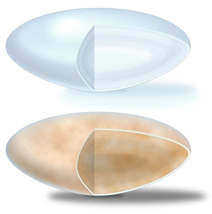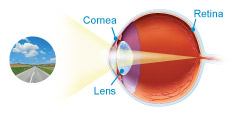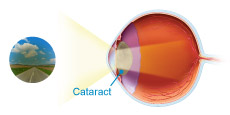 A cataract is a clouding of the eye’s naturally clear lens. Your eye becomes like a window that is frosted or yellowed. Cataracts are a common cause of vision loss, especially as we age, but they are treatable.
A cataract is a clouding of the eye’s naturally clear lens. Your eye becomes like a window that is frosted or yellowed. Cataracts are a common cause of vision loss, especially as we age, but they are treatable.
- Learn more about the risk factors for cataracts.
- Learn more about cataract surgery.
- Learn more about IOL implants.
- See what vision with a cataract looks like.
How would I know if I’m developing cataracts?
The only way to know for certain is when your Eye M.D. does a dilated eye exam (described below). Get a baseline exam at age 40, when early signs of disease and changes in vision may start to occur. Your Eye M.D. will let you know how often you should return for follow-up exams. At any point, if you have symptoms or risks for eye disease, see your Eye M.D. Because your risk for cataracts and other eye diseases increases as you get older, starting at age 65 you should see your Eye M.D. every year. A complete eye examination will rule out any other condition that may be causing blurred vision or eye problems.
Most age-related cataracts develop gradually. As a result, you may not immediately notice changes in your vision when cataracts first develop. Also, the amount and pattern of cloudiness within the lens can vary. If the cloudiness is not near the center of the lens, you may not be aware that you have a cataract.
How Cataracts Affect Vision

Light enters the eye through the cornea, passes through the natural crystalline lens and is accurately focused onto the retina, creating a crisp, clear image.

As the eye ages, the lens becomes cloudier, allowing less light to pass through. The light that does make it to the retina is diffused or scattered, leaving vision defocused and blurry.
In time, you may have symptoms such as:
- Painless clouded, blurry or dim vision;
- Increasing difficulty seeing at night or in low light;
- Sensitivity to light and glare, seeing haloes around lights;
- Colors seem faded or yellowed;
- The need for brighter light for reading and other activities;
- Needing frequent changes in eyeglass or contact lens prescription; or
- Double vision within one eye.
How are cataracts diagnosed?
During a comprehensive, dilated eye exam, your Eye M.D. uses several tests to check for cataracts:
- Slit-lamp: This device uses an intense line of light to illuminate the eye’s cornea, iris, lens and the space between the iris and cornea. The doctor is able to examine the eye in small sections, making it easier to detect abnormalities.
- Retinal exam: When your eye is dilated, the pupils are wide open so the doctor can more clearly see the back of the eye. Using the slit lamp and/ or an instrument called an ophthalmoscope, the doctor looks for signs of cataract and if present, the extent of the clouding. Your Eye M.D. will also look for signs of glaucoma and other potential problems with the retina and optic nerve.
- Refraction and visual acuity test: This refers to the sharpness and clarity of your vision. Each eye is tested individually for the ability to see letters of progressively smaller size. The doctor determines whether you have 20/20 or less acute vision with the best possible glasses during the refraction.
Once I know I have cataracts, what should I do?
- Have an eye exam every year if you’re older than 65, or every two years if younger.
- Protect your eyes from UV light by wearing 100 percent UV blocking sunglasses and a hat.
- If you smoke, quit; smoking can increase cataract progression.
- Use brighter lights for reading and other activities; a magnifying glass may be useful, too.
- Limit night driving once night vision, haloes or glare become problems.
- Take care of any other health problems, especially diabetes.
- Get the right eyeglasses or contact lenses to correct your vision; when it becomes too difficult to complete your regular activities, consider cataract surgery.
Do not use eye drops or other treatments that claim to dissolve or remove cataracts. There is no proven way to dissolve cataracts with eye drops. Surgery is the only way to remove cataracts.
Last reviewed and updated in May 2009,
by the American Academy of Ophthalmology.

